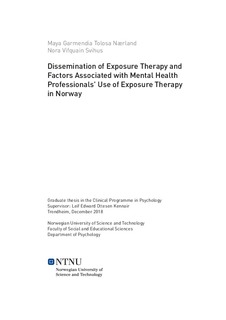Dissemination of Exposure Therapy and Factors Associated with Mental Health Professionals' Use of Exposure Therapy in Norway
Master thesis
Permanent lenke
http://hdl.handle.net/11250/2588604Utgivelsesdato
2018Metadata
Vis full innførselSamlinger
- Institutt for psykologi [3086]
Sammendrag
Despite the large body of empirical evidence supporting the efficacy of exposure therapy for anxiety disorders, several studies have found that few therapists actually use exposure therapy when treating patients with anxiety disorders. The aim of the present study was to investigate the dissemination of exposure therapy and factors associated with mental health professionals’ use of exposure therapy in Norway. A sample of 419 Norwegian mental health professionals from various professional backgrounds completed an online survey about their use of therapeutic approaches when treating clients with specific phobias, panic disorder, agoraphobia, social phobia, obsessive-compulsive disorder or post-traumatic stress disorder; during the last six months. The survey also included questions about use of specific core exposure techniques and factors hypothesised to influence use of exposure therapy. The majority of participants reported using exposure therapy often, however less than one third reported using core exposure techniques such as habituation and behavioural experiments. Endorsing a cognitive, behavioural and/or metacognitive orientation and acquired knowledge about exposure therapy were the most important predictors of more use of core exposure techniques. While the most important predictor of less use of core exposure techniques was endorsement of perceived contraindications for use of exposure therapy. The results suggest that the majority of Norwegian mental health professionals may appear to provide exposure therapy in a manner that is insufficient. Implications for the clinical training of therapists and the educational programmes for clinical psychologists in Norway are discussed.
